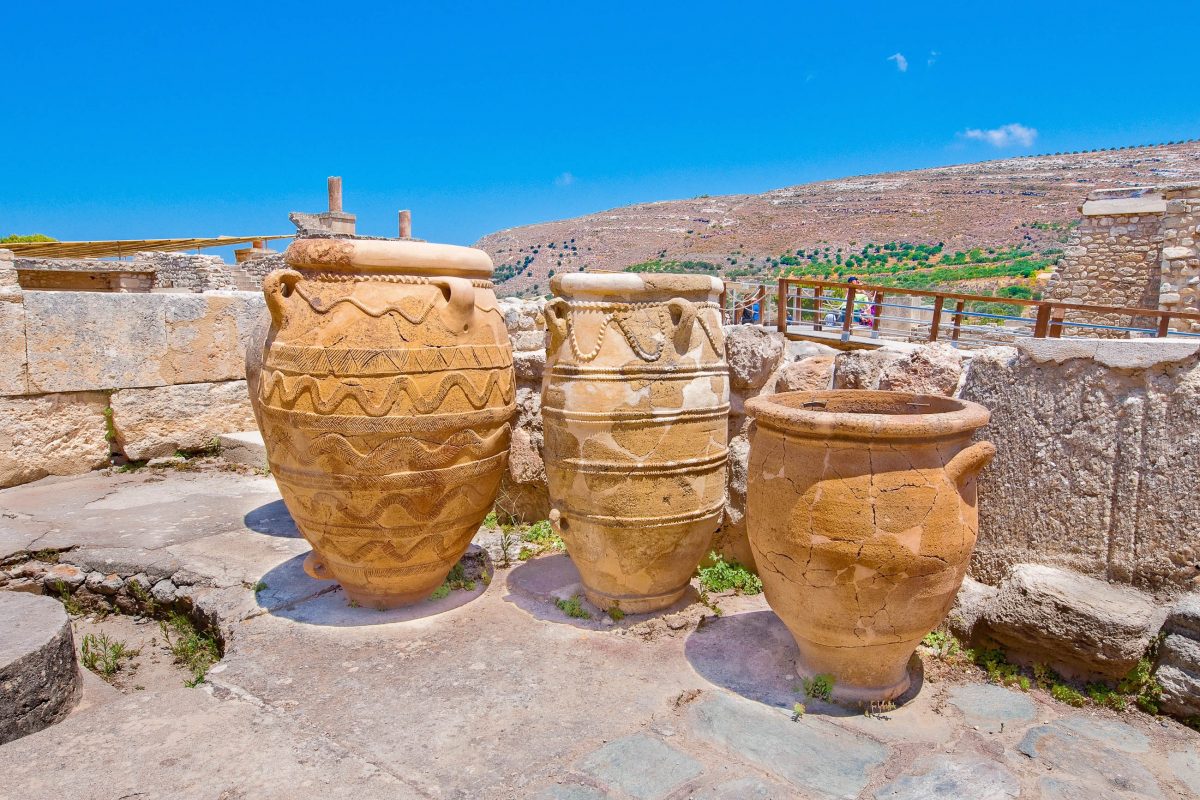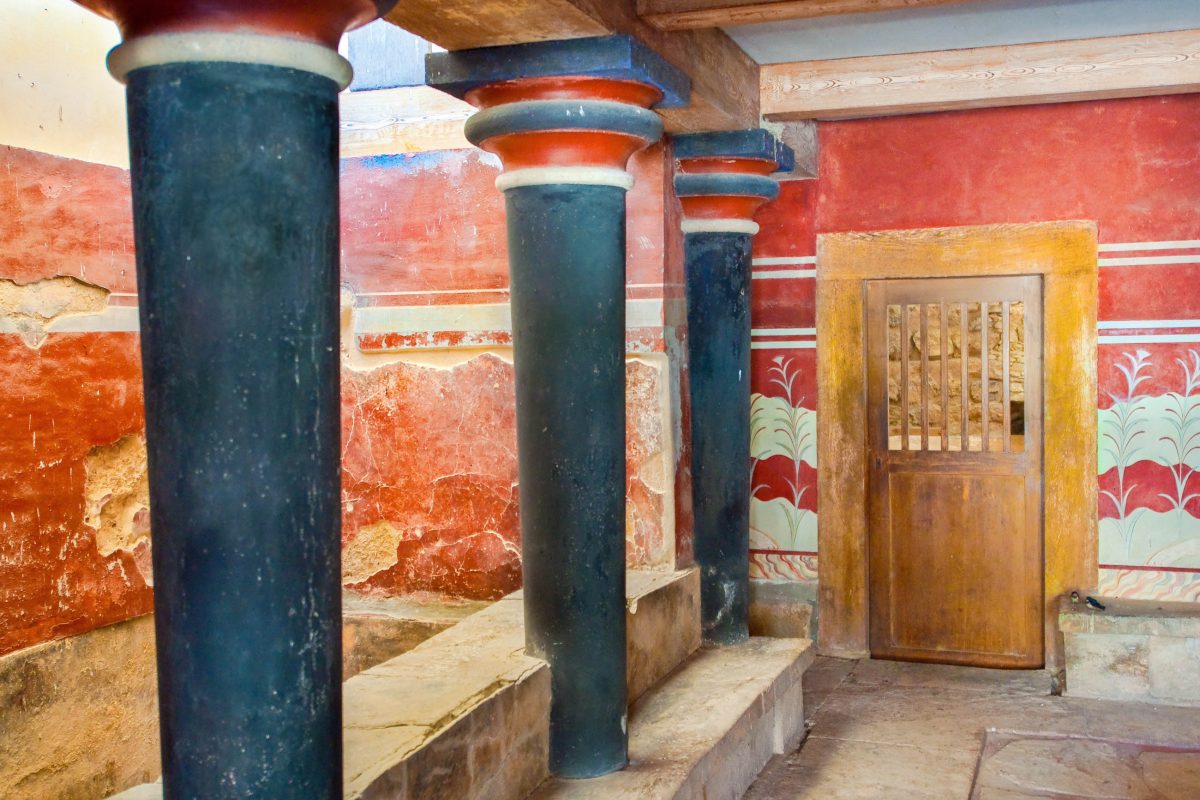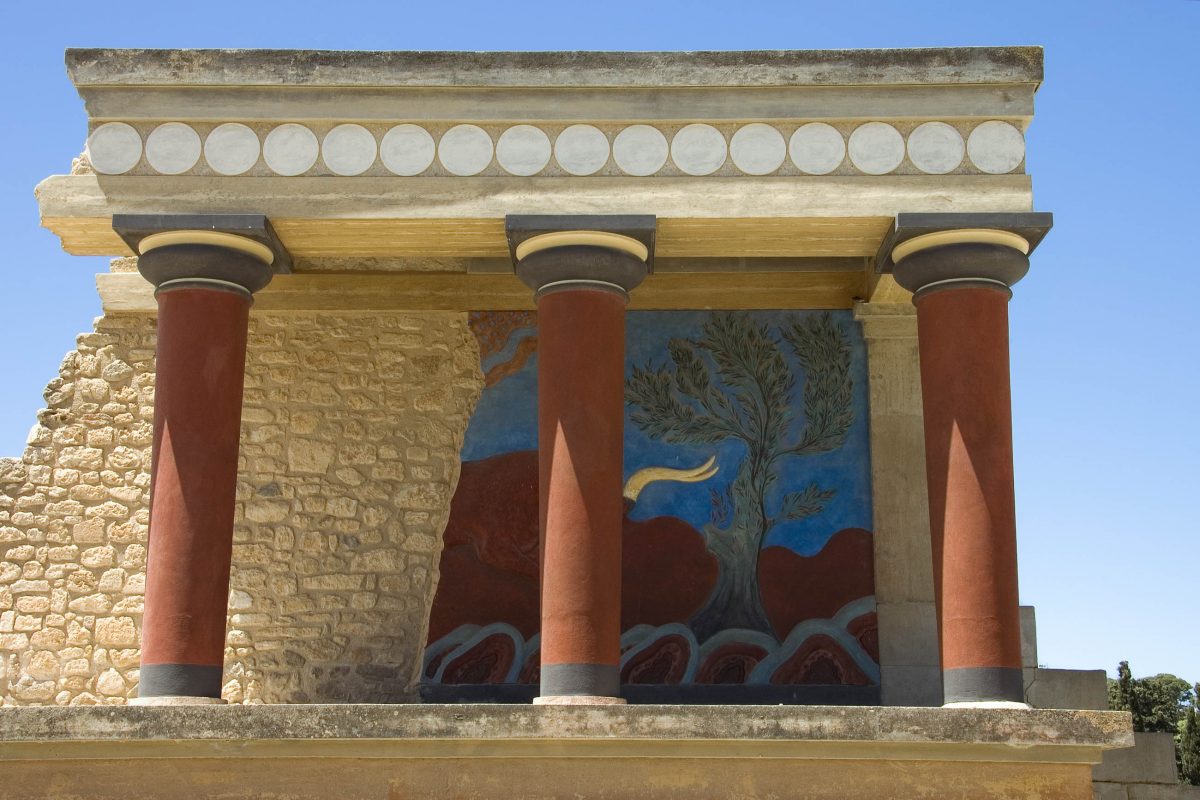Die Ruinen von Knossós südlich von Heraklion stammen vom größten Palast des mythologischen Kreta-Königs Minos. Er beeindruckt durch seine schieren Ausmaße und seine ausgeklügelte Bauweise.
Die Ruinen des Palastes von Knossós befinden sich im Osten der Insel gleich südlich von Kretas Hauptstadt Heraklion und gehören zu unseren Top 10 Sehenswürdigkeiten von Kreta. Die uralten Relikte aus dem Altertum sind die meistbesuchte Attraktion der beliebten Mittelmeerinsel.
Der Palast von Knossós war einst Sitz von Minos, Sohn des Zeus und der Europa und König von Kreta. Er gilt als Begründer der minoischen Kultur und ist vor allem durch die legendäre Figur des Minotaurus bekannt. Dieses Ungeheuer, halb Mensch, halb Stier, soll sich König Minos in einem Labyrinth unterhalb seines Palastes gehalten haben.
Inhaltsverzeichnis
BILDER: Ruinen von Knossós auf Kreta
Fotogalerie: Ruinen von Knossós auf Kreta
Wann wurde der Palast von Knossós gebaut?
Der Palast von Knossós entstand um 1900 vor Christus. Mit einer Fläche von knapp 8km² war der fünfstöckige Prachtbau doppelt so groß wie andere minoische Paläste auf Kreta und damit eines Königs würdig. Er wies keinerlei Verteidigungsanlagen auf, denn das minoische Volk war allen möglichen Feinden in allen Belangen haushoch überlegen. Ohne Kriegsgefahr konnten sich die Minoer auf Handel und Wissenschaft konzentrieren.
Die Ruinen des heutigen Palastes von Knossós stammen aus dem Zeitraum um 1450 vor Christus. Um 1700 wurde der Palast das erste Mal durch ein Erdbeben zerstört, danach jedoch wieder aufgebaut. Nach dem zweiten verheerenden Erdbeben blieb der Palast in Trümmern liegen, die bis heute konserviert werden konnten.
Was ist das Besondere an Knossós?

Der gigantische Palast hatte der minoischen Königsfamilie und ihren Bediensteten einst 1.400 Räumlichkeiten zu bieten, die mit meisterhaften Fresken und Skulpturen geschmückt waren. Ihre verschachtelte Anordnung mit schmalen Gängen und unzähligen Türen, Treppen und Rampen war wahrscheinlich der Nährboden für das Labyrinth des Minotaurus.
In der Mitte sorgt ein weitläufiger Innenhof für frische Luft und Spaziermöglichkeiten und ein eigenes Palast-Theater sorgte für kulturelle Unterhaltung.
Das Besondere am Palast von Knossós war jedoch seine außerordentlich fortschrittliche Bauweise. Geniale unterirdische Terrakotta-Konstruktionen sorgten im Palast für fließendes Wasser und ausgeklügelte Lüftungsschächte für angenehme Kühle im Sommer, wodurch die Lebensmittel lange frisch blieben und die Hygiene sich deutlich besserte (es gab nämlich auch Wasserklosetts und warmes Wasser zum Baden).
Entdeckung des Palastes von Knossós

Die umfassendsten Ausgrabungen der Ruinen von Knossós wurden vom britischen Archäologen Sir Arthur Jon Evans durchgeführt, der als Entdecker der minoischen Kultur galt. Nachdem der Palast von Minos schon vom antiken Dichter Homer erwähnt wurde, kaufte er kurzerhand das Grundstück auf dem Hügel Kephala, auf dem er die Ruinen vermutete.
Zuvor hatte bereits der griechische Hobby-Archäologe Minos Kalokairinos einige Tonscherben und Steinmauern gefunden. 1900 starteten die Ausgrabungen, an denen bis zu 100 Mann arbeiteten und tatsächlich wurde der prunkvolle Palast mit zahlreichen kunstvollen Fresken zu Tage gefördert.
Evans begann, Teile des Palastes aus den Trümmern zu rekonstruieren, was in der weltweiten Archäologie zu einem großen Aufschrei führte. Für das Aussehen des antiken Palastes gab es keinerlei Anhaltspunkte und Evans mutwilliges Aufeinandertürmen von Fantasie-Bauten wäre normalerweise undenkbar gewesen. Nichtsdestotrotz erntete er in London großen Ruhm für seine Arbeit und wurde sogar zum Ritter geschlagen.
Besuch des Palastes von Knossós

Die monumentale Palastruine kann heute nahezu ohne Einschränkungen besichtigt werden. Für die Besichtigung von Knossós sollten rund 2 Stunden eingeplant werden.
Im Herzen der Ruine befindet sich der Thronsaal, so benannt nach einem kostbaren Alabaster-Thron. Die Fundamente lassen die gigantischen Ausmaße des Palastes von Knossós erahnen.
Zahllose Räume schmiegen sich an vergleichsweise enge Gänge und an manchen Stellen kann man auch die Obergeschoße betreten. Hie und da lässt sich der einstige Prunk des Palastes von Knossós an den kunstvoll geschmückten Treppenhäusern, aufwändigen Fresken und säulenbewährten Galerien erahnen.
Einige der meisterhaften Wandmalereien wurden rekonstruiert, ein ganz besonderes Prachtstück ist das weltberühmte Delfinfresko über einer Tür.
Achtung Hitze!
Wie auf den meisten archäologischen Stätten Griechenlands herrscht auch unter den Ruinen von Knossós kaum Schatten, was in der griechischen Sommerhitze sehr schnell unangenehm werden kann. Daher unbedingt an Sonnenschutz und einen ausreichenden Wasservorrat denken!
Um der Mittagshitze zu entgehen, empfiehlt sich eine Besichtigung am frühen Morgen. Um diese Zeit ist auch der Besucherandrang noch erträglich und die prachtvollen Räumlichkeiten können in Ruhe besichtigt und vor allem auch fotografiert werden.
Parkmöglichkeiten gibt es übrigens direkt vor dem Eingang zum Palast, man muss nicht unbedingt an der Straße stehenbleiben, auch wenn man hektisch in eine (meist kostenpflichtige) Lücke gewunken wird.
Um der Hitze zu entgehen, kann man Knossós auch in der Nebensaison besuchen, denn der Palast hat ganzjährig geöffnet. An den Sonntagen von November bis März (und auch noch an ein paar anderen Tagen) ist sogar der Eintritt kostenlos.
Weiterführende Links:
Öffnungszeiten und Eintrittspreise in den Palast von Knossós





